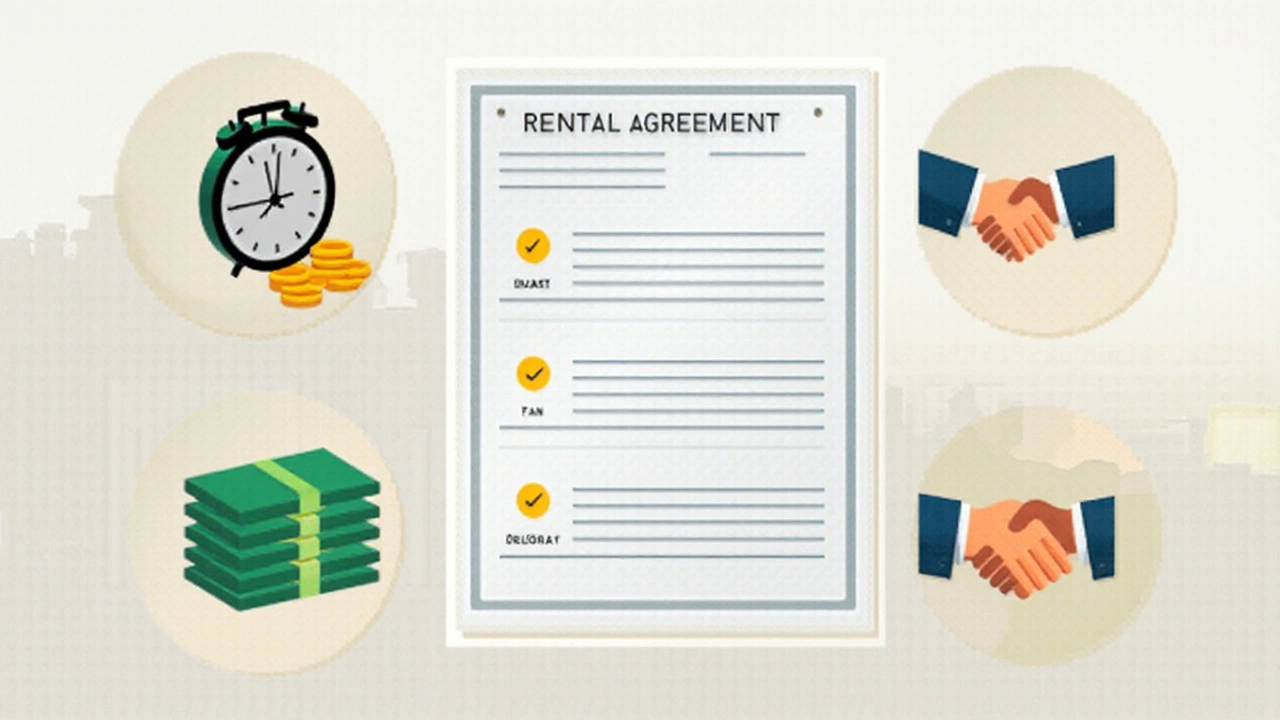Living in a rental property comes with its unique set of joys and challenges. Whether you’re renting out a spare house or securing a new home, having a well-written rental payment agreement is crucial. This document serves as a safeguard against misunderstandings and ensures that both parties are on the same page, legally and financially.
An effective rental payment agreement sets clear expectations about payment methods, due dates, and consequences of late payments. It's not just about protecting the landlord’s investment; it also shields the tenant from unexpected costs and disputes. Navigating this legal terrain might seem daunting, but armed with the right knowledge, you can craft an agreement that suits your needs.
- Understanding the Importance of a Payment Agreement
- Essential Elements of a Rental Payment Agreement
- Tips for Writing Clear and Effective Terms
- Handling Late Payments and Fees
- Common Pitfalls to Avoid
Understanding the Importance of a Payment Agreement
In the realm of real estate, the notion of a **rental payment agreement** holds significant weight, marking the foundation of a harmonious relationship between landlord and tenant. This document, seemingly mundane, is paramount, not as a mere formality, but as a fundamental device to avert misunderstandings and disputes. Let’s delve into why crafting this agreement is indispensable for both parties involved.
A rental payment agreement effectively establishes the rules of engagement. It sets a clear timeline for financial transactions, delineates payment destinations, and addresses the permissible modes—be it through electronic transfer, check, or cash. Imagine the scenario devoid of such an agreement—a chaotic and uncertain labyrinth of miscommunications and haphazard transactions. The ability to refer back to a well-constructed agreement can be a lifesaver in matters of disagreement. Besides, this document is a safety net, providing a traceable method to assure that all parties are compliant with the initial terms. According to a study by Rent.com, properties with formalized agreements experienced fewer disputes compared to those without. This statistic underscores the protective nature of these agreements in maintaining transparency and order.
The simplicity embedded in a **simple lease agreement** can sometimes be deceptive. While it might seem sufficient to verbally agree on terms, without formal documentation, either party might overlook or misinterpret aspects over time. This becomes glaringly evident in situations involving late fees. The agreement not only outlines such fees but also justifies them legally. One generic yet apt statement often advised, as echoed by Nolo, a renowned legal website, is 'an ounce of prevention is worth a pound of cure.' For a tenant, signing this agreement offers predictability and minimizes unforeseen expenses, while for a landlord, it fortifies their right to a steady income stream.
Moreover, in certain areas, the existence of a **landlord tenant agreement** is a legal requirement. It is crucial for the landlord to operate within the regulatory framework specific to their locality. These agreements can stand as legal evidence if an unfortunate legal dispute arises. A well-documented contract gives credence to each party’s claims, thus facilitating smoother resolution processes. The accessibility of such agreements not only fosters trust but also establishes a professional tone from the onset. Consequently, landlords are encouraged to provide tenants with a comprehensive copy that they can easily reference whenever necessary.
"In matters of truth and justice, there is no difference between large and small problems, for issues concerning the treatment of people are all the same." - Albert Einstein
Across the globe, property management practices differ vastly; however, the essence of having a **house rent contract** remains unchanged. It’s more than just listing names and rental fees. It's a detailed blueprint that can include clauses about maintenance responsibilities, alteration permissions, and even occupancy limits, tailored to the dwelling's unique context. With such specificity, potential friction points are addressed upfront, thus reducing the risk of tensions flaring up unexpectedly during the tenancy duration. This thoroughness ensures that what starts as a business relationship can flourish into a mutually beneficial engagement for both landlord and tenant alike.
Essential Elements of a Rental Payment Agreement
When drafting a rental payment agreement, it’s crucial to include certain key elements that will ensure clarity and legal compliance. At its core, this document should clearly outline the financial terms of the lease. Begin by specifying the total amount of rent due and how often payments should be made, whether it’s monthly, bi-weekly, or annually. This might sound basic, but a miscommunication regarding payment frequency can lead to significant conflict. Listing the due date precisely, such as the first day of each month, helps both parties manage their finances better.
Another essential component is the specification of acceptable payment methods. Whether you’re accepting checks, bank transfers, or electronic payments, make sure this is clearly stated in the agreement. This minimizes confusion and helps prevent any assumptions about convenience payments, which might not align with the landlord’s preferred method. Landlords and tenants should also include details about late payment penalties. For example, you can specify a percentage of the rent that will be added if payment isn’t received by a certain grace period, which is commonly three to five days after the due date. Explicitly stating these terms in advance reduces the likelihood of disputes.
"A comprehensive payment agreement is the cornerstone of a successful landlord-tenant relationship," says real estate expert Anna Sullivan.
It’s also wise to incorporate a clause about rent increases. This should outline how and when these adjustments can occur, whether it be annually based on inflation rates or other factors. Transparency here builds trust and helps tenants plan accordingly. Legal guidance suggests that including responsibilities for utilities and maintenance can be beneficial. Clearly delineate which utilities the tenant is responsible for and outline any periodic maintenance tasks they need to oversee, such as changing air filters or checking smoke detectors. This not only prevents disputes down the line but also ensures the property is maintained in good condition.
Addressing Special Circumstances
Occasionally, unique situations demand special attention within a house rent contract. Suppose a tenant is temporarily laid off and discusses adjustments before signing the contract. You can draft a provision that addresses this, stipulating temporary adjustments with a clear return to the original terms once the situation resolves. Including such clauses reflects an understanding and cooperative relationship and can create goodwill. Lastly, ensure you have a termination clause that includes the notice period required for either party to end the lease. Legally, this can prevent disputes arising from abrupt departures or evictions. Usually, the notice period is about 30 days, giving both parties adequate time to make necessary arrangements. Though it might seem like a lot of detail, addressing these components meticulously will significantly reduce headaches in the future.

Tips for Writing Clear and Effective Terms
Creating a simple lease agreement is not just about jotting down terms on paper, but it’s about crafting a symphony of words that echo clarity and fair play. When penning down the terms, ensure they are written in clear and concise language that can be understood by all parties involved. It’s essential for both landlords and tenants to avoid jargon and overly complex legal language that might confuse or mislead. Instead, use straightforward terms that accurately convey the conditions agreed upon. Maintaining clarity in communication is key, as many disputes arise not from bad intentions but due to miscommunication.
One practical technique to strengthen the clarity of your house rent agreement is to use numbered lists for important clauses. By doing this, you provide structure to the document, making it easy for the reader to follow each term individually. Consider including important aspects like the payment methods accepted, the due dates, and any penalties for late payments. These might seem like small details, but they play a significant role in ensuring that both parties are aware of their responsibilities and obligations.
Moreover, it’s wise to include specific examples where necessary to illustrate more complex terms. For instance, if there’s a provision for what constitutes a breach of agreement, offer a clear example. This practice helps to eliminate ambiguity and paints a vivid picture of what actions might trigger repercussions. A well-illustrated example can often explain a term better than a lengthy paragraph. Here’s a quote from Judge Learned Hand, a renowned jurist:
“Words are not pebbles in alien juxtaposition; they have only a communal existence; and not only does the meaning of each interpenetrate the others, but all in their aggregate take their purport from the setting in which they are used.”These words underscore the importance of context in contractual language.
Sometimes, tenants or landlords might require slight modifications to the original agreement due to unforeseen circumstances. In such situations, establish a simple amendment clause within the initial agreement. This clause should outline the process through which changes can be requested and consented to by both parties, ensuring that any changes are documented and agreed upon in written form. By doing so, the document not only supports the amicable alteration of terms but also maintains the integrity of the initial agreement.
In a study featured by the National Apartment Association, clear communication in rental agreements reportedly helped reduce tenant-lawyer consultations by a remarkable 40%. This statistic emphasizes that clarity translates to fewer disputes and smoother transactions. Therefore, practicing transparency by regularly reviewing the terms with all involved parties can pave the way for long-term, harmonious relationships.
Handling Late Payments and Fees
One of the most crucial sections in a rental payment agreement is dealing with late payments and fees since it helps maintain the financial integrity of the transaction. Late payments can be challenging for landlords, affecting cash flow and potential maintenance schedules. By clearly spelling out the consequences of late payment, landlords can encourage timely payment and minimize disputes. Tenants too benefit from understanding these terms as it helps them plan finances better to avoid additional costs.
A well-structured agreement will stipulate when rent is due, typically at the start of each month, and outline a grace period if one is granted. Following the grace period, late fees can be applied, which can be set as a fixed amount or a percentage of the total rent. For example, a 5% surcharge after a grace period could be implemented to deter late payments. According to NoLo, a renowned resource for legal advice, "Automatic late fees must be fair and reasonable to be enforceable." This underscores the importance of setting fees within acceptable ranges so they are not perceived as punitive.
"Unreasonable late fees might end up in small claims court," warns Attorney Janet Portman. "Landlords should sincerely consider their tenant population when enforcing late fees."This echoes the principle that fairness should be a guiding light in all aspects of a rental agreement, including late fees. Every landlord should communicate these terms clearly when signing the agreement to avoid any misunderstandings.
Additionally, the agreement should specify how late fees will be collected. Options may include adding the fee to the following month's rent or requiring immediate payment upon notification. Landlords can decide whether additional late fees will accrue over prolonged delays, but it’s crucial to establish these rules upfront. Tenants who are aware of these conditions are more likely to prioritize rent payments, knowing they have a defined structure to adhere to, minimizing the risk of eviction.
Interestingly, statistics suggest a proactive approach can dramatically decrease the need for late fee applications. A survey conducted by the National Multifamily Housing Council found that 83% of renters prefer paying online, which not only increases the likelihood of on-time payments but also helps in tracking financial records effectively. Allowing multiple payment methods, such as credit cards or digital wallets, can further facilitate punctual payments, fostering a smoother landlord-tenant relationship.
Common Late Payment Traps
While striving to maintain fairness, landlords must be wary of potential pitfalls in handling late payments. Including clauses that specify that tenants are not allowed to use their security deposit to pay late rent is vital. Furthermore, clearly stating that paying late twice consecutively could be grounds for lease termination safeguards both parties in the long run. In reviewing agreements, mutual understanding and transparent communication are valuable tools in preserving the contractual relationship.

Common Pitfalls to Avoid
Embarking on the journey of drafting a rental payment agreement involves navigating potential traps that could lead to disputes or financial loss. One prevalent pitfall is the lack of clarity in payment terms, which can create confusion about due dates and acceptable payment methods. This often results in unwelcome conflicts. Clearly defining whether payments should be made via bank transfer, checks, or digital wallets ensures both parties are on the same footing and prevents missed payments due to overlooked emails or postal delays.
An often overlooked yet crucial aspect is addressing the fine details of default and late payment penalties. Many agreements leave this area vague, leading to potentially unenforceable terms. It’s wise to specify exact late fees, ensuring they are fair and compliant with local laws. A well-drafted penalty clause serves as a deterrent to late payments and fosters a smoother tenant-landlord relationship. Not accounting for inflation or cost of living increases is another common error; consider clauses for periodic rent adjustments to avoid disagreements when living costs rise.
Documentation is another essential part that is often mishandled. While verbal agreements might strike as simple, a paper trail provides undeniable proof. Recording all terms, acknowledgments, and amendments protects both parties. Overlooking maintenance responsibilities can also lead to disputes. Clarity here is key, whether it concerns minor fixes or major repairs, stating who pays for what keeps the relationship free of unnecessary strain. Avoid assumptions and clearly define what the tenant versus the landlord is responsible for, thereby minimizing conflicts over duties.
Ignoring legal advice is another pitfall that can have serious repercussions. While DIY agreements may seem cost-effective, consulting a legal professional ensures the document is airtight and adheres to jurisdictional laws. It's especially critical to have thorough understanding of local rent control laws, eviction procedures, and tenant rights, which can vary significantly. Relying solely on online templates without customization is risky, as these often fail to meet the specific needs or legal requirements of all jurisdictions.
Finally, remember that ongoing communication is crucial. After signing the agreement, maintain regular check-ins to discuss any potential issues or changes. This helps to address problems before they escalate and demonstrates commitment to maintaining a healthy tenant-landlord relationship. The simplicity of a house rent contract should not overshadow the necessity of a thorough, well-constructed agreement. Foreseeing and anticipating these common pitfalls ensures smoother interactions and better peace of mind for both landlords and tenants.





